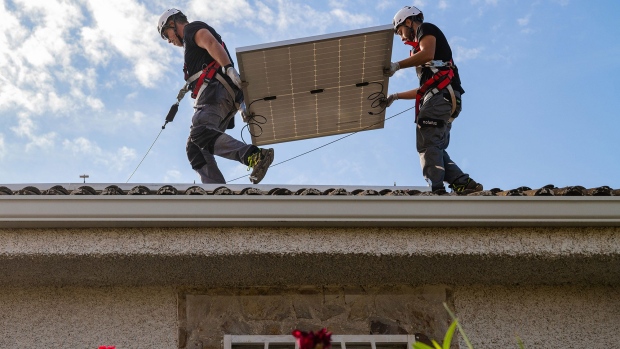May 26, 2022
Rooftop Solar Takes Off in Spain, Aiding Europe’s Bid to Shun Russian Gas
, Bloomberg News

(Bloomberg) -- Solar energy installations on rooftops have been surging in Spain, giving more hope that at least one European country can speed up its transition away from gas power in the wake of Russia’s invasion in Ukraine.
Solar capacity on private properties increased 102% last year by 1.2 gigawatts, according to Spanish industry group UNEF. And there are indications this trend is continuing.
Barcelona-based utility Holaluz-Clidom SA, which sells only renewable electricity and installs solar panels, said it had its busiest quarter ever in the first three months of the year. It added 613 rooftop systems, bringing the company’s portfolio total to 7,023 sites. After acquiring three installation companies over the past year, the company expects to add panels to 50,000 rooftops across Spain before the end of 2024. This could bring its total capacity to 250 megawatts — around a tenth of what’s already on Spanish roofs today — assuming Holaluz’s estimate that its average installation has 5-kilowatt potential.
Holaluz, which has been selling renewable energy since 2010, is planning to quickly scale up its business through mergers and acquisitions. Major utilities like Iberdrola SA and specialized installers, such as Powen and Solari Power, are also vying to gain a bigger share of Spain’s growing rooftop solar market.
The rush for the rooftops comes amid soaring energy prices across Europe and a host of new financial incentives by the Spanish government to encourage homeowners to invest in cleaner technology.
Read More: Record European Power Prices Show Costly Path Away From Russia
The war in Ukraine has been pressuring Europe to quickly diversify its energy sources. Russia ships about 150 billion cubic meters of gas to Europe via pipelines every year, and another 14 billion to 18 billion cubic meters of LNG.
The European Commission is currently assessing whether it can triple its solar and wind capacities by 2030 to save 170 billion cubic meters of yearly gas consumption by the end of the decade.
It also estimates the EU could cut gas consumption by an additional 2.5 billion cubic meters a year by simply rolling out rooftop solar systems by an extra 15 terawatt hours in 2022. Clean energy research group BloombergNEF said this would equal 12 gigawatts to 15 gigawatts, depending on the location.
While sunny Spain seems like it would be a natural leader in Europe for rooftop solar, the country has lagged other European nations. Spain only had 2.7 gigawatts installed at the end of last year, compared with frontrunners Germany and Italy, which had 44 gigawatts and 17.6 gigawatts, respectively, according to industry group SolarPower Europe.
Read More: How Solar Power Is Distributed Around the World
Spain’s rooftop solar installs have been doubling almost every year since the government decided in 2018 to scrap a so-called “sun tax” — a levy that consumers had to pay to access the national grid once their solar panels were up and running. Last year the government earmarked 1.3 billion euros ($1.4 billion) of post-Covid EU recovery funds to boost rooftop solar installations, energy storage and renewable heating systems in Spanish homes.
To be sure, rooftop solar isn’t a cheap upgrade. Holaluz says its average panel installation costs “less than 5,000 euros,” which still can be a lot for homeowners to pay upfront. But cities such as Barcelona and Madrid are offering their citizens up to 50% off their property taxes for as much as three years if they put panels on their roofs.
More recently, rising electricity bills have provided their own incentive. For Spanish households on a regulated monthly tariff, the average charge was about 143 euros in March this year, according to Spain’s main consumers association OCU. This was a 130% increase from the same time last year and a 33% jump from February.
Carlos Garzon, 69, who installed a set of solar panels on the rooftop of his property in Madrid only a few months ago, said he’s already enjoying its benefits. “My electricity bill has halved, but on a sunny day I’ve still enough extra power to recharge my hybrid car,” he said.
At a continued frenzied pace, Spain’s Ministry for Environmental Transition expects that installed rooftop solar capacity in the country could reach as much as 14 gigawatts by 2030, with more than a third installed on residential buildings.
Renewable energy companies like Holaluz are even more ambitious with their vision for the future. The firm estimates Spain has 10 million residential rooftops ready to be exploited and has outlined a plan to install more capacity than the actual need of a specific household, which would allow homeowners to sell the surplus to network customers in the neighborhood.
As Europe grapples with the high political and economic price of importing fossil fuels from Russia, Holaluz’s Chairman Carlota Pi said sourcing energy locally will ultimately be the least costly option for consumers. “That’s the best way to produce zero-kilometer energy, reduce transportation costs and make electricity cheaper and more sustainable,” she said.
©2022 Bloomberg L.P.


